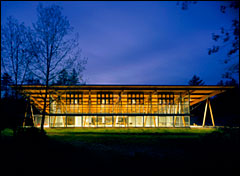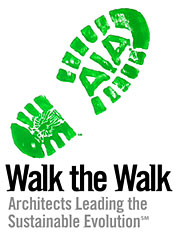If you build it, they will come. But if you build it green, you just may be able to save the planet.

R.K. Stewart.
Or so says a recent report, which suggests that green building could help cut North America’s greenhouse-gas emissions more quickly and less expensively than any other measure. And word is getting out about the promise of this fast-growing field — some have even called 2008 the official “Year of Green Building.”
It’s no wonder the field is building momentum — sustainable design is one of the top priorities for the American Institute of Architects, the leading professional membership organization for more than 80,000 architects and design professionals. The organization has even adopted a 2030 Challenge aimed at halving fossil-fuel consumption in buildings by 2010 and reaching carbon neutrality by 2030. And AIA is committed to helping its members reach these aggressive goals with continuing research on effective tools and techniques.
So where is the future of green building headed? I got the chance to ask that very question of architect R.K. Stewart, a past president of the AIA who helped focus the organization on promoting efficient and sustainable design strategies. During our chat, Stewart dismissed some of the misperceptions about green building (it’s not always more expensive!), introduced AIA’s new web-based green-building tool, and suggested we look to our own neighborhoods to celebrate sustainable design.
Do you see many students getting into the green building field? How are you encouraging that?

The AIA sheds light on sustainable building practices.
Photo: Nic Lehoux
We’ve got to work our way forward to be not overly optimistic, but realistic in saying that yes, we do have the means to change the profile of how we use energy and how climate change events transpire. I think we’re at a point where, hopefully, people are going to start to understand that we have to integrate this into everything that we do. It becomes essentially part of our DNA; you don’t think about it anymore. That’s one of the main things that we’re trying to do with our initiatives at AIA is to just make people understand that good design is sustainable design, and that’s the only way you can practice.
We’re trying to make our way forward on this, and we’ve got to do it at all levels of the education process … [W]hether you’re a seventh-grader in Oregon or an architecture student in Dubai, you have an opportunity to impact the future of the planet. Do something, do anything; just doing nothing is no longer an option for us.
What are some of the obstacles you face when trying to persuade clients to move in a green direction?
Perhaps the biggest impediment that we run into on a regular basis is the issue of cost. On the one hand, there are a lot of things we can do that really have no cost or are transparent in cost, so we should be picking those things up and doing them day in and day out. Don’t even think about it; it’s just what you do. But it’s changing what you do that’s really important.
One of the biggest problems we’ve got in the real-estate industry right now is that people tend to separate capital costs to build or renovate a building from the operations and maintenance cost. … [We think it’s important to] have the folks who are going to be running the building at the table during the design process so you know things that will have the impact are considered, and make that change.
We’re talking with the financial markets to try and get them to understand that this change is important and it needs to happen, and begin to consider preferred lending rates for buildings that are sustainably designed. They maintain their value longer, they’re more attractive to tenants and owners, and the lower operating costs are going to do nothing but have greater impact as the cost of energy continues to rise.
How are you working to change perceptions about green building?
We’ve just launched a web-based learning tool called Soloso that provides access to a lot of this information — for the public as well as our members.
We’re moving to a point in time where we’re going to be reevaluating the architecture-student performance criteria — and what we expect the outcomes of architectural education to be. There’s going to be a lot more focus on the integrative nature of sustainable design so that it really becomes part and parcel to the entire profession — and not just an isolated specialty.
What got you interested in sustainability?
It’s always been part of a track within the profession, and one that I’ve been interested in, but looking forward now in the latter part of my career — what’s the legacy that this generation of the profession wants to leave? As people begin to understand that architecture is public policy — architecture shapes us and enables our lives — where do we want to be on this issue? Are we going to let it be defined by others who are more narrowly focused on parts of the issue? Are we going to look at it from our perspective as integrating and creating community for people? So it was an opportunity for this generation of practitioners to leave that legacy behind that sets not only the tone for the future, but assures that there is a future.
Where in the U.S. are you seeing exciting progress?
We’ve been able to develop some really great coalitions with the U.S. Conference of Mayors. They’ve adopted our language — the 2030 challenge — and the National Association of Counties has also done that. So I’m quite proud of the progress we’ve made in terms of getting the public policy message out there with the policymakers and decision-makers who are going to enable a lot more of this to happen.

In terms of a region, it’s hard to say because there’s progress everywhere. But you could point to places like Chicago, Seattle, San Francisco, and Portland, who have been out there and are making progress — a great amount of progress — over time. D.C. has taken some big steps forward in terms of its regulatory environment, recently requiring green buildings. Boston has done the same thing. New York is starting to move now in terms of getting some progress.
But in terms of the projects themselves, you can go to any community in the country now — I don’t care where you are — and you’ll find projects that are making progress. They’re all pretty exciting; there’s just so much going on, I want to celebrate them all. So just go out to wherever you live and you can find them. Go look at them, explore them, and encourage other people to talk about them and do something similar.
Do you see this as a trend or something concrete that’s going to continue on?
Oh, I think it has to [continue] … business as usual leads to a loss in the quality of life. It leads to tremendous health problems; it leads to problems in terms of survivability of the species … The argument that [changing the way we do things] is going to destroy economies and destroy whole businesses, I find difficult to believe. I mean, you look across other industries in other times: The car was going to destroy life as we know it; well, it shifted things. When we came forward with seatbelt regulations, that was going to put the automobile industry out of business; well, no, they figured out how to do it without destroying the industry and without putting everybody out of work, right?
Humans are innovators. If we just have the will to say we’re going to change what we do fundamentally and we give people the opportunity and the tools to do it, they will step up. We’ve got to get alignment of the political process and the financial markets to begin to underwrite it, but as soon as it becomes clear that people expect it and want it, I think it’s going to change. This is not just a trend of the decade. We’re talking about a decades-long effort here …


